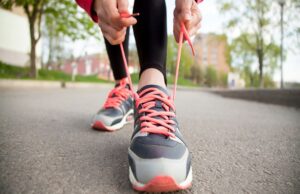There are thousands of models of running shoes on the market. The choice is so great that it is sometimes difficult to find shoes that fit. In order to choose the pair of running shoes that suits you, it is necessary to ask yourself the right questions. In a specialized running store, the salesperson will help you with this process. But when you buy online, here are the criteria to look at.
How will I use my running shoes?
“To run !” you will say. Yes, but there are different ways of running and this will influence the choice of running shoes. It is even recommended to have 2 different pairs of running shoes that you choose according to the days and sessions.
Alternating training with 2 pairs of shoes would also be beneficial against injuries. This would lead to up to 39% fewer injuries according to a Luxembourg study.
If you mainly run on the road, you can choose a pair of running shoes with a classic contact sole.
If you run on muddy terrain or in the mountains, trail shoes will then be more suitable to avoid slipping or even falling.
For those who run regularly on the track or in competition and want to have a feeling of lightness, running shoes with low cushioning and low weight are preferred. Not as shoes for all training, but as shoes to keep for quick sessions or in competition.
The lifespan of running shoes is about 600 kilometers for light shoes or carbon plate shoes . And up to 1000 kilometers for running shoes with a little more cushioning.
How to choose the cushioning of your running shoes?
A running shoe has many elements: a week of contact with the ground, a midsole (we talk about cushioning), a sockliner and the top of the shoe, called the upper (the mesh in English).
The cushioning of the shoe
Each brand has its own technology for the midsole of its running shoes. Its role is to dampen the shock wave with each support on the ground and is also a marketing argument. Adidas offers its Boost, Asics its gel, Hoka One One its maximalist cushioning, Nike sometimes its air bubbles or lately a carbon plate for its famous Alphafly …
Most of the time the midsole is made partly of EVA. It is a foam that has both flexibility and cushioning properties. It also has the advantage of being light.
With each support on the ground, the runner absorbs 2 to 3 times his body weight. It is therefore preferable to choose the cushioning of your running shoes according to your weight. Runners under 80kg are better off choosing low or intermediate cushioning. And runners over 80kg intermediate or heavy cushioning for more stability.
The drop of the shoe
The drop of a shoe is the difference between the height of the front of the shoe and the back of the shoe. One of the debates in recent years is questioning shoes with a high drop.
Because that would force the runner to attack with the heel. When the runner lands on the heel, the force exerted on the ground is greater than if the runner is running on the middle or the front of the foot. This attack on the heel could be the cause of a good part of the injuries.
In contrast, minimalist shoes have little or no cushioning, which puts more strain on the foot and calves. Progression must imperatively be respected for runners wishing to try this type of shoe.
Without going to extremes, shoes with a low drop of 0 to 4mm (difference in height between the heel and the front of the shoe) are a good compromise.
The pose of support: pronator, universal or supinator
When you put your foot on the ground, some runners tend to have an inside ( pronator ), normal (universal), or outside (supinator) foot pose. You can notice it in the wear of your shoe or on a back video filming you running. Some models of running shoes offer these corrections so that you have a more flat foot pose.
These artificial reinforcements can be reassuring, but it is also interesting to do some muscle strengthening exercises and foot work to correct these imbalances in the long term.
Feel good in your sneakers
When choosing a pair of shoes, feel free to try on 3 or 4 different pairs. It is also advisable to run about fifty meters with it to see if it suits you. It’s certainly short, but already gives a moving overview over a few strides. You will ensure that the shoe is suitable for the width and shape of your foot.
Each brand offers quite a different fit. It is therefore very likely that you will feel much better in one brand than in another. According to a British study, the price of the shoe has no connection with the comfort of this one .
Practical recommendations for choosing shoes
If you’re already a runner, take your old shoes to the salesperson at a specialty store. He can help you choose a model based on the wear of your old shoes.
Do not take a shoe that is too small because the volume of the foot tends to increase very slightly when running. It is also better to try on your shoes in the evening rather than in the morning. Because the foot also tends to slightly gain volume during the day.
Consider trying on your shoes with running socks.
If you change brands, rely on the US size rather than the EUR because manufacturers often have the same US unit. However, there may be variations for EUR sizes because the conversion table is specific to each brand.
Running shoes comparator
To make your choice according to the criteria detailed in this article, you can find the I-Run shoe comparator to obtain the comparison between the models best suited to your practice.


